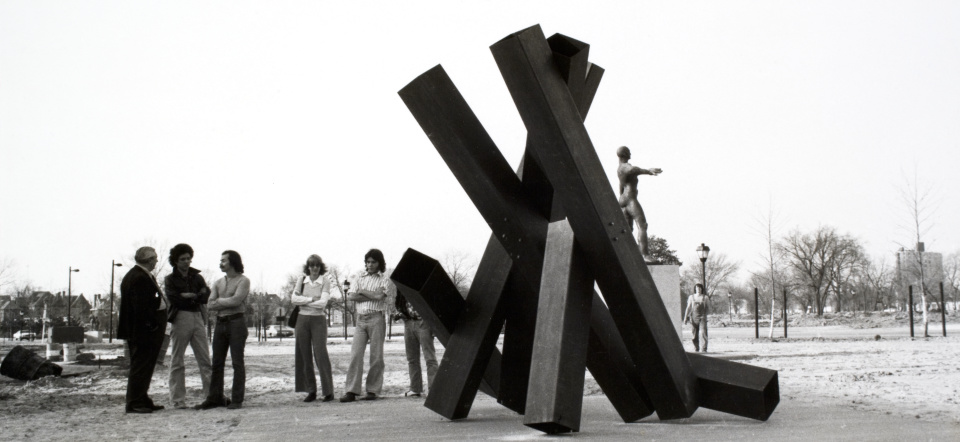- Open today, 10 am to 5 pm.
- Parking & Directions
- Free Admission
On the Move: Cor-Ten Sculptures
– Kimberli Gant, PhD, the McKinnon Curator of Modern & Contemporary Art.

The Bill and Leslie Hennessy Sculpture Walk on the Chrysler Museum campus recently welcomed two large-scale steel works. Tony Rosenthal’s Big Six and Floor Kite XII by Jasha Green are the newest additions to the landscape between the Museum entrance and the Perry Glass Studio. Both sculptures have been in the Chrysler Museum’s permanent collection since the late 1970s, but were recently relocated from the corner of Grace Street and W. Olney Road, at the back edge of the campus, to a more prominent placement in front of the Museum.
The conservation and move of Big Six and Floor Kite XII truly enhances the entrance and immediately introduces visitors to the Chrysler Museum’s breathtaking collection. The sculptures were initially placed off Grace Street more than forty years ago to welcome visitors when the entrance faced Downtown Norfolk. During renovations, the entrance was moved to Mowbray Arch facing The Hague, leaving the monumental pieces with less prominence and visibility.

Installation of ‘Big Six’ by Tony Rosenthal off W. Olney Rd. (Walter Chrysler, Jr. on the far left and the John Knox Tower on the right.)
After Chrysler staff decided to put the sculptures back in the path of visitors, conservators identified the need for restoration treatment to revive these wonderful works. Over the years, the Cor-Ten steel sculptures fell victim to the effects of corrosion and became weak at the joints. Chrysler Conservator Mark Lewis brought in sculpture conservators Andrew Baxter, Steve Roy, and Scott McKee from Richmond to stabilize the works, move them to their new home, and revive them to their former splendor. Long-term preservation required putting the works on above-grade foundations to arrest future corrosion. In the past, water had collected in certain areas and completely undermined the stability of Big Six and Floor Kite XII. Eroded metal was ground away and new metal inserts were welded into place. The new metal was then patinated to match the original surfaces. “This work reinforced the connections and made it possible to safely lift and move the pieces,” Lewis said. Once stabilization was complete, the sculptures were carefully rigged with lifting straps and slowly relocated to their new home. They were then securely bolted in place onto new cement piers. A berm was created, which elevates the sculptures and protects them from rising sea levels and the corrosive effects of poor drainage. New landscaping provided the finishing touch.
Tony Rosenthal (1914–2009), who primarily worked in woods and metals, was a sculptor known for creating large, abstract, geometric pieces. He began working in this style in the 1960s after years of using a more figurative approach. His best-known piece is Alamo, a 15-foot cube that is now colloquially known as the Astor Place Cube (image below). It was installed in Astor Place in Manhattan in 1967 as part of a city-wide sculptural exhibition titled Sculpture in Environment.[1] Though Big Six is not a cube, it presents six large rectangular columns on an angle and certainly fits within the style for which the artist was known.
Jasha Green (1923–2006), another prominent artist of the mid-twentieth century, worked actively in the 1970s. Though he was a renown abstract sculptor, he also worked in other mediums such as printmaking and collage. He was very interested in Op-Art as well as Surrealism, so most of his images, both two- and three-dimensional, were clusters of abstracted shapes. Like Rosenthal, Green utilized metals in his large outdoor sculptures. Floor Kite XII, though not what one might traditionally think of when they think of a kite, incorporates Surrealist qualities as the work shifts perspectives as one circles around it.
Conserving and moving Big Six and Floor Kite XII was the first of several Chrysler Museum conservation projects to be funded by a Sherman Fairchild Foundation grant over the next three years. The grant will also be used to restore other important works in the Museum’s collection such as daguerreotypes of Virginia; a nineteenth-century photo album of images collected by Irene Leache and Anna “Annie” Cogswell Wood; The Angel Appearing to the Shepherds, an immense painting by Thomas Cole, and Woman in a Pergola with Wisteria and While Shepherds Watched Their Flocks at Night, stained-glass windows by Louis Comfort Tiffany. Stay tuned to learn about these amazing objects and how they are being restored to their former splendor.
[1] Robet Smithson, Irving Sandler, and Alexander Nagel, “An Interview,” RES: Anthropology and Aesthetics, no. 63/64 (Spring/Autumn 2013): 289.


